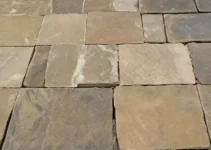Installing a concrete driveway requires more than just laying down concrete. To avoid unattractive cracks in your new sidewalk, it is important to install expansion joints.

Photo by DRIVEWAYS BY DESIGN – Browse landscaping ideas
Joints in concrete pavements fall into two basic categories:
1) Joints that allow movement (isolation and expansion joints)
2) Joints that control cracking of the concrete (control or contraction joints)
First category, expansion joint, also known as an isolation joint, is a space put between adjoining sections of concrete to help control cracking.
In fact there is a difference between expansion joint and isolation joint.
Isolation joints are used to separate the pavement from any abutting buildings, existing pavements, or rigid structures such as drainage pits, access holes or columns which may cause restraint of the pavement and thereby increase the risk of cracking.
Expansion joints are used in large areas of paving to accommodate expansion and may be placed between a driveway and adjacent concrete slabs, such as the foundation of a garage or a house.
Expansion joints allow each section of concrete to move independently of the others. Concrete expands primarily due to elevated temperatures during periods of hot weather and contracts in cold and, without expansion joints to provide room for this movement, large cracks could occur.
Where a concrete slab adjoins other building surfaces it is normal to provide isolation joints. These are usually the same material as the expansion joints.
1 – Spacing:
So, spacing of control joints is critical. The number of expansion joints necessary in a driveway depends on its length.
- – Make sure the joints on your driveway are spaced at intervals of 15 feet or less.
- – It is a common practice to make the spacing equal to the width of the driveway. The ratio of width to length should not exceed 1:1.5.
- – If your driveway slab will have sharp 90 degree corners, control joints should extend from these corners out into the slab.
- – For decorative work, joints should if possible be located to suit the proposed decorative pattern or finish.
- – If your sidewalk is a long path you will want to use expansion joints but expansion joints are not needed if contraction joints are placed every 5 feet along the sidewalk.
2 – Size and Thickness:
Size and thickness of your expansion joints depend upon the thickness of your driveway or sidewalk concrete.
- – So, a driveway expansion joint, as a rule, is from 1/2-inch to 3/4-inch (12.7 mm to 19 mm) wide and as deep as the driveway is thick (5 to 6 inches). Expansion joints must cover the entire thickness of the concrete and extend from end to end, when in place.
- – All sidewalks should be at least 4 inches thick.
- – The expansion joint may be placed a little below the top surface of the sidewalk if you are rounding the edge or giving a sharp edge detail to the concrete.
- – The expansion joint should never extend above the top of the sidewalk.
- – Thicker concrete is a good idea for driveways. However, reinforcing steel is a must. Steel is very inexpensive and it helps to strengthen the concrete significantly. Steel will hold cracked slabs together.
3 – Material:
Materials used for expansion joints must be tolerable to extreme weather and temperature conditions.
- – Preformed materials, such as asphalt fiberboard, rubber, and plastic or cork composition planks, are common joint filers.
- – However, any material used as filler for a driveway expansion joint must be extremely resilient and not subject to becoming soft in hot weather or brittle in cold. These are fixed to the formwork before the concrete is poured.
- – Expansion joint material is available in pre-molded sizes or you can cut it to your own preferred size.
- – The 12mm joint is formed in the concrete with something like softwood or polystyrene foam that is then removed when the concrete has set. The joint is then filled with the sealer compound.
4 – Note:
Expansion joints in the driveways of older homes are often filled with weeds as the result of a wooden driveway expansion joint used by building contractors in years past. When the wood rots, all that remains is a crack as wide as the board that originally filled it. The space quickly fills with dirt, rocks and weeds and becomes an eyesore.
Solution: Clean out the joints, wash them with power washer and install proper material in them. However, if gaps are wider than the purchased filler, expandable, weatherproof caulk can be used to fill in the excess space.
Pavement or Asphalt – For Your Driveway – What to Choose? (howtobuildahouseblog.com)


